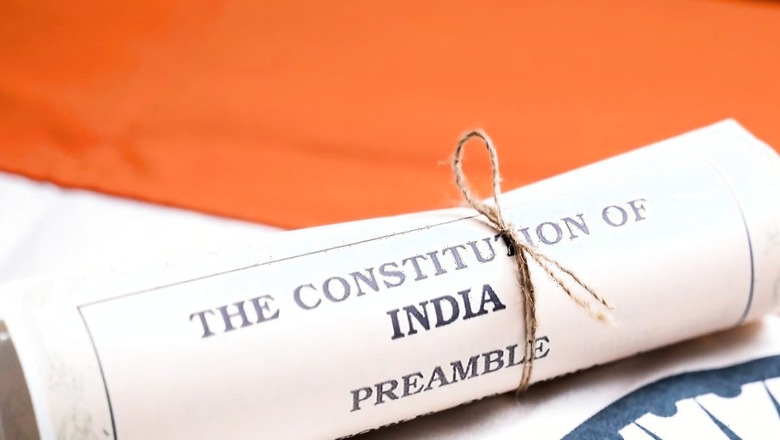
views
Independence Day invariably reminds us of the freedom fighters who devoted their productive years, if not their lives, to liberate India from British rule. Popular narratives of the freedom movement often focus on the attainment of freedom itself, while the question of the form of government is relegated to the background. It is taken for granted, as though India would have been a Parliamentary democracy in any event. However, it is readily apparent that this is not a rational proposition.
The revolt of 1857, while it might have ousted the British, was not driven by the principles of liberal democracy. This was not merely because the uprising occurred in the mid-19th century, when democracy was still evolving even in Britain, but also because it was disconnected from the political ideas being developed in Calcutta, Bombay, and Madras during the 1850s. It was a far cry from the British Indian Association (est. 1851), Bombay Association (est. 1852), and Madras Native Association (est. 1852). Thus, the 1857 uprising lacked the political ideas that influenced the American War of Independence (1775-83) and the French Revolution (1789-99).
It was the precursors and pioneers of the freedom movement who invested in the struggle with intellectual capital. Known variously as reformists, moderates, or liberals in different epochs, they can be categorised as constitutionalists who advocated for political reform aimed at a more representative and progressive government in British India. This intellectual culture prevented India’s freedom movement from becoming merely a crude struggle for power. They formed organisations such as the British Indian Association, Indian Association, Bombay Association, and Poona Sarvajanik Sabha, which eventually led to the formation of the Indian National Congress (est. 1885). Even the Congress, which was initially an annual event rather than an organisation, was dominated by these constitutionalists for a long time.
A section of them, including Dadabhai Naoroji, Justice M.G. Ranade, Pherozeshah M. Mehta, Gopal Krishna Gokhale, Surendranath Banerjea, W.C. Bonnerji, Badruddin Tyabji, and Pandit Madan Mohan Malaviya, are remembered as moderates, particularly in connection with the extremist versus moderate dispute within the Congress. They were unsuccessfully challenged by the extremists led by Lokamanya Tilak at Surat in 1907. The extremists were expelled, and their challenge diminished after the incarceration of Tilak and the departure of Aurobindo Ghose.
The moderates, led by Surendranath Banerjea, later separated themselves from the Gandhian Congress in 1917. Their subsequent history under the nomenclature Indian Liberal Party (1923), comprising leaders like Tej Bahadur Sapru, C.Y. Chintamani, C.H. Setalvad, and H.N. Kunzru is less prominent as they were often dismissed as stooges of the British, though they boycotted the Simon Commission (1928) and made serious efforts for political reforms in India. However, by that time, constitutionalism had long ceased to be the property of a clique; it had become mainstream in Indian politics. Thus, Moti Lal Nehru and Sir Chettur Sankaran Nair, although not part of the Liberal Party, could be said to be constitutionalists par excellence. While one formulated the Nehru Report, the other drafted the Report of the Central Committee, thereby providing an alternative to the Simon Commission.
II
Why did British rule sustain the growth of constitutionalism? To begin with, the East India Company introduced a new form of government in India—impersonal government. The Company’s rule was one by a body corporate rather than an individual such as a Maharaja or Nawab. The Regulating Act of 1773 established the position of Governor-General, who was required to make decisions based on a majority within an executive council. The same method was applied to the Governors in the Madras and Bombay Presidencies. All of them were paid servants of the Company, who received a monthly salary, had a limited tenure, and wielded limited powers.
In the late 18th century, Indians faced a genuine difficulty in relating to an impersonal government. They invented an imaginary personality, whom they called Company Bahadur. They were not entirely incorrect, as a company is indeed a legal entity in modern jurisprudence, capable of suing and being sued under its own name. The British apparently concluded that the Revolt of 1857 stemmed from the fact that a company could not command the loyalty of Indians as a monarch could. Sir Syed Ahmed Khan, in his The Causes of the Indian Revolt (1873), attributes the Revolt partly to the inadequate and infrequent number of durbars held by the Governors-General. This led to a decline in loyalty in a land accustomed to the grandeur and ceremony of rulers in durbars (p. 45).
That the British perceived this psychological disconnect (with impersonal government) as a factor in the outbreak of the 1857 Revolt is amply proven by the fact that Queen Victoria was brought into the Indian picture in 1858 with Queen’s Proclamation. She was later elevated to the queer stature of “Queen-Empress” in 1876 by the Benjamin Disraeli government. Subsequently, three Durbars were held during British rule—in 1877, 1903, and 1911. The intention was to demonstrate to Indians that their ruler was a real person, who lived and breathed, and had a family. The ruler was not merely a collective entity like the bureaucracy—a two-headed demon with the Secretary of State based in London and the Governor-General based in Calcutta and Simla, both holding office for a limited term at the pleasure of the monarch.
III
Whereas the laymen might have found an impersonal government strange, the more advanced section of society took to it like fish in the water. They generally represented the emerging English-educated class. They realised that, for the first time, one could criticise a government without being labelled an enemy. They had a voice and could express their opinions without fear of prosecution (provided they did not call for the disestablishment of British rule). The constitutionalists were fascinated by the English institution of the House of Commons.
Raja Ram Mohan Roy (1772-1833), though strangely reviled by many nationalists today, might be considered the founder of constitutional agitation in India. He visited the House of Commons when that chamber of the British Parliament was debating the Representation of the People Bill, 1831. However, the first prominent constitutionalist was the father figure of moderates, Dadabhai Naoroji. He began as a professor of mathematics at Elphinstone College in Bombay and reached his apex by becoming a Member of Parliament in Britain in 1893. He had previously served as the President of the Calcutta Congress in 1886. Dadabhai, being a mathematician by training, made statistics an integral part of political discourse. Some of his essays in Poverty and Un-British Rule in India (1901) read like dissertations in applied economics. His famous “drain of wealth” theory remains a popular argument in India against British colonialism.
The constitutionalists placed immense emphasis on the study of facts and figures from government documents and other sources. Justice Mahadev Govind Ranade (1842-1901), the brain behind the Poona Sarvajanik Sabha, mentored Gopal Krishna Gokhale (1866-1915) as a young man. T.K. Shahani (1919) in an early biography of Gokhale, tells how hard a taskmaster Ranade was. Gokhale was instructed to study the Government Blue Books, Green Books and Red Books issued from time to time; cumbrous statistics, masses of evidence, voluminous correspondence, various statements and comments proceedings from diverse sources (Gopal Krishna Gokhale: A Historical Biography, P.59). No wonder, then, that Gokhale rose to become one of the masterly orators in the Imperial Legislative Council, and his speeches on the annual budget could put Viceroy Lord Curzon on the defensive.
Surendranath Banerjea (1848-1925), formerly of the Indian Civil Service, was not an economist. His hallmark was advocating for the introduction of an elective element in the legislative councils to make them more representative of the people. As the co-founder of the Indian Association (est. 1876), he rose to prominence by coordinating a national agitation against the lowering of the minimum age for Indian Civil Service aspirants in 1877. This unpopular decision by Her Majesty’s Government adversely affected the prospects of aspirants from India. Long before Shashi Tharoor, he was the first Indian to win a debate at Oxford Union (1890), where he defeated Lord Hugh Cecil on the need to replace nomination with elections as the principle for filling legislative councils.
Pherozeshah M. Mehta (1845-1915), a barrister, emphasised accountable municipal government based on the principle of elections, simultaneous examinations for the ICS in Britain and India, and the separation of judicial and executive functions in government.
Independent India developed an uncharitable opinion about these constitutionalists. Their methods of prayers, petitions, and appeals were viewed as submissive and utterly inadequate to win freedom. We tend to overemphasise “freedom,” that is, seizing sovereign authority from the British, whereas the freedom movement encompassed much more than just the achievement of sovereign power. We often pay minimal attention to the content of freedom, such as the form and policy of government. The constitutionalists were masters of economy, law, and ideas on representative government. They made us aware that every clause mattered and every word counted when it came to statutes. They schooled us in parliamentary democracy long before India became a full-fledged one.
It was not until the Lahore Congress of 1929 that the demand for Purna Swaraj (complete independence) was officially made. However, the constitutionalists emphasised the ideal of self-rule (Swaraj was first used from the Congress platform by Dadabhai Naoroji in 1906) and dominion status, which would have made India akin to self-governing dominions of Britain like Australia, New Zealand, or Canada.
The constitutionalists abhorred the dramatic moments generally associated with revolutionaries and believed in developing the actual political content for an independent nation. Guided by reason rather than passion, they were, in reality, incisive critics of British policies on merit. The idea that they were submissive to British rule is only partly true. They recognised that the matrix of rule provided an opportunity to advance Indian claims, which was not possible under the personal rule of any potentates. Without them advancing the ideas of constitutionalism, India’s freedom movement could not have flowered into the pages of the Constitution.
The writer is author of the book ‘The Microphone Men: How Orators Created a Modern India’ (2019) and an independent researcher based in New Delhi. The views herein are his personal. Views expressed in the above piece are personal and solely that of the author. They do not necessarily reflect News18’s views.



















Comments
0 comment